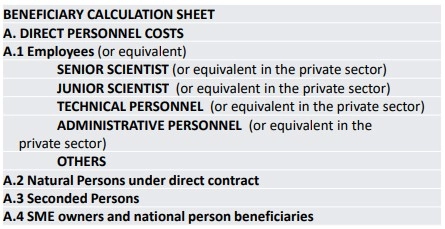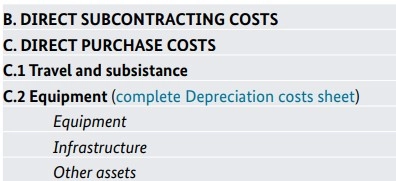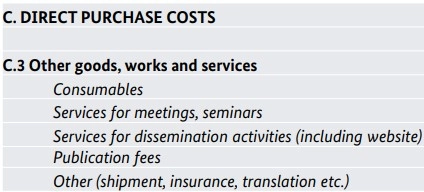Lump sum funding for beginners
Published on 30/05/2024 by Marlene Kopf
Lump sum funding – a buzzword that is cropping up more and more frequently in Horizon Europe. Wondering what it’s all about?
Here are the most important facts.

Which costs are eligible for lump sum funding in Horizon Europe?

Actual cost accounting, the most frequently used method in Horizon Europe to date, has several prerequisites:
- Basic principle: profitability and project necessity have occurred and are verifiable (proof: accounting or project result)
- The costs incurred during the project term
- The expenses were planned in the application and necessary for the project implementation
- The costs are in accordance with national law
No differences to the "actual cost-based" model regarding these important aspects:

- The rules on the composition of the consortium remain the same as before.
- The funding rate (depends on the measure and type of institution).
- Continued application of general funding principles: Transparency, co-financing, no profit-making, no cumulation ban.
- Presentation of objectives, methods, and expected results is required as in all applications.
- Evaluation: The procedure and requirements are the same.
Lump sum funding application: How does it work?

- The cost reimbursement model is specified in the call for applications and cannot be freely chosen by the applicants.
- A standard form for applications has to be used (more space: 50 instead of 45 pages).
- New: For Horizon Europe lump sum funding, a dedicated Excel spreadsheet for detailed budget planning should be filled in for each project partner.
What are the general funding principles in Horizon Europe?

- Transparency: the amount of the costs must be comprehensible.
- Co-financing requirement: the institution’s own contribution (e.g. for equipment, indirect costs).
- Prohibition of profit-making.
- No cumulation ban: Resources from Horizon Europe can/should be combined with other EU funding, such as structural funds and general funding principles.
- These principles are valid for lump sum funding as well.
Why is the EU Commission increasingly using lump sum for funding?

- Flat-rate subsidies reduce the risk of incorrect billing; this is a great opportunity for newcomers to apply for Horizon Europe funding.
- More financial planning security for beneficiaries.
- There is great potential for simplification in project management, e.g., by eliminating financial reports.
- Most importantly, with lump sum funding in Horizon Europe, the focus shifts from financial management to project content.
The type of tender determines the grant model
- Actual costs funding scheme:
- Reimbursement is based on actual costs incurred.
- The exact amount of costs must be documented.
- The amount of costs must be verifiable.
- Horizon Europe Lump sum funding:
- Reimbursement is made when the planned activities have been carried out.
- The cost amount must be planned plausibly and convincingly beforehand in the application.
- Proof of the amount of the costs is not necessary.

Horizon Europe lump sum projects can choose between two options

Option 1 | Option 2 |
Preset amount | Lump sum is specified by the applicant |
The budget must correspond to the specified amount | The amount required for the implementation of the project can be freely determined |
The resources used for the project must be described | The chosen lump sum must be justified by the funds made available |
What requirements must be met for the lump sum funding to be paid out?
- The requirements for the total budget are specified in Annex 2, Art. 6.1 of the Grant Agreement (lump sum).
- Work packages have been completed.
- The results (according to Annex 1) have been achieved within the project duration.
- Exception: the final report can be submitted after the project ends.
- Additional special regulations can be added if appropriate.

Lump sum funding - budget planning

- Budget planning is very detailed.
- The dedicated Excel spreadsheet must be downloaded from the application area of the Funding and Tenders portal and attached as an annex to the B part of the application.
- Costs correspond to actual necessary project costs and must convince the reviewers. High costs should be justified (especially personnel costs)!
Detailed cost planning as a basis for lump sum funding in Horizon Europe
The Excel table for budget planning is broken down into individual work packages and partners.
Eligible costs include
- Personnel costs
- Costs for subcontracts
- Acquisition costs (e.g. travel expenses, equipment, consumables)
- Other direct costs (e.g. internal cost allocation)
- Flat rate for indirect costs: 25% on A. + C.
Budget table cost categories
- Units and cost per unit are filled in –> these refer to the costs per PM.
- PM is not defined.
- Take cost increases over the term into account!


- C1: Units and cost per unit (= cost per trip) are filled in
- C2: The depreciation list requires detailed information on the time of acquisition, proportion of use in the project, etc.

- Units and costs per unit are filled in –> these refer to the number of consumables/services and planned costs.

Dashboard for personnel costs
- The reviewer briefing contains a link to the Personnel Cost Dashboard, which assesses the level of personnel costs (based on actual reported costs in HEU projects since 2021).
- Initial experience indicates that the dashboard is consulted during the review process.
–> Tip: If a partner’s personnel costs are significantly higher than indicated in the dashboard for the respective type of organization, they must be explained.
Work package planning for lump sum projects
- Payment is made according to completed work packages (WP); therefore, it is important to structure the project carefully. At the end of each review period, only completed WPs are paid.
- Plan as many WPs as necessary, but no more than manageable.
- Work packages with longer duration (e.g., management, dissemination, and Exploitation) can be split, e.g., one WP Management per reporting period.
- Each partner’s share in individual WPs must be recognizable from the project application.
- Deliverables should be suitable for checking the project’s progress. They serve as proof of work and results provided and justify the funding.
- The partners’ responsibility for individual deliverables should be recognizable

The goal for WPs:
- As many as necessary and reasonable (many WPs = many deliverables).
- Work packages serve as meaningful subdivisions of a project.
- Work packages with a long duration may be divided.
Keep in mind:
- An activity is not a work package.
- A single task is not a work package. Every WP has to consist of at least two tasks.
- Progress (e.g. half of the attempts) is not a work package.
- A period of time is not a work package.
Evaluation of lump sum projects

- The evaluation is based on the Horizon Europe standard criteria of excellence, impact, and implementation.
- You can find out more about how to organize the individual sections here:
- Budget planning is taken into account during the project implementation.
- Assessment of appropriateness: Is the cost estimate reasonable/not excessive? The planned resources should be sufficient to carry out the project.
- If the lump sum is excessive, the European Commission will make a specific budget proposal and adjust the project funding amount in the GA.
- If the lump sum is too high/low, a lower score for implementation is possible.
Grant Agreement preparation
- The GA preparation follows a standard process, without contract negotiations, only necessary changes
- Correction of errors and inconsistencies
- If necessary, clarification of ambiguities
- If necessary, adjustment of the lump sum if the value is slightly overstated
- A special Model Grant Agreement for Horizon Europe lump sum projects is used.
Recognition of work packages in lump sum projects

- Recognition is granted when the planned work has been completed (not linked to the project’s success).
- (Scientifically necessary) adjustments to the project are possible; either via contract amendments or through justifications in reports.
- In the final payment, work on incompletely concluded WPs is paid pro rata.
Lump sum - budget shifts

- The consortium has budget autonomy: after signing the GA, shifts within its own budget and between partners are always possible.
- Contract amendments are required if changes in work packages or in the distribution of tasks are to be mapped.
- Recommendation: If the responsibility changes, amend the contract!
Lump sum - documentation
Required:
- Technical documents
- Publication, prototypes, deliverables
- Documents of good scientific practice, as in all projects
Not required:
- Timesheets, payslips
- Depreciation calculations
- Invoices, cost statements, CFS
Lump sum - practical experience

- Some projects require more deliverables than usual.
- It is impossible to omit deliverables, but changes to the deliverables are possible.
- Milestones can be postponed.
- Amendments to the GA have a similar time horizon as usual.
- 99% of work packages in ongoing lump sum projects have been accepted and fully paid –> cuts in 1% of projects
Lump sum - further information
- Info portal on Horizon Europe lump sum funding of the European Commission
- If your question is not answered in this summary, try the FAQ of the European Commission or
- Ask your National Contact Point (NCP) for help!